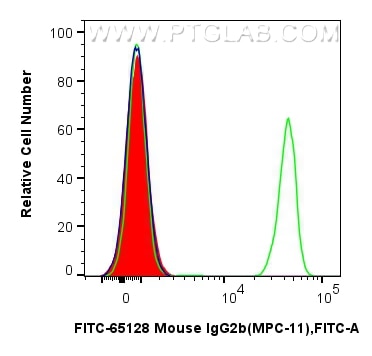Tested Applications
| Positive FC detected in | human PBMCs |
Recommended dilution
| Application | Dilution |
|---|---|
| Flow Cytometry (FC) | FC : 0.2 ug per 10^6 cells in a 100 µl suspension |
| This reagent has been tested for flow cytometric analysis. It is recommended that this reagent should be titrated in each testing system to obtain optimal results. | |
| Sample-dependent, Check data in validation data gallery. | |
Published Applications
| IF | See 1 publications below |
Product Information
FITC-65128 targets IgG2b Isotype Control in IF, FC applications and shows reactivity with n/a samples.
| Tested Reactivity | n/a |
| Host / Isotype | Mouse / IgG2b, kappa |
| Class | Monoclonal |
| Type | Antibody |
| Immunogen |
N/A Predict reactive species |
| Full Name | immunoglobulin heavy chain 3 (serum IgG2b) |
| Gene Symbol | IgG2b Isotype Control |
| Gene ID (NCBI) | 16016 |
| RRID | AB_2883791 |
| Conjugate | FITC Plus Fluorescent Dye |
| Excitation/Emission Maxima Wavelengths | 495 nm / 524 nm |
| Form | Liquid |
| Purification Method | Affinity purification |
| UNIPROT ID | P01867 |
| Storage Buffer | PBS with 0.09% sodium azide and 0.5% BSA, pH 7.3. |
| Storage Conditions | Store at 2-8°C. Avoid exposure to light. Stable for one year after shipment. |
Background Information
The MPC-11 immunoglobulin is useful as an isotype-matched control. The MPC-11 immunoglobulin has an unknown binding specificity and is used as an isotype control for mouse IgG2b antibodies. This antibody has been quality-tested for flow cytometry as negative control.
Protocols
| Product Specific Protocols | |
|---|---|
| FC protocol for FITC Plus IgG2b Isotype Control antibody FITC-65128 | Download protocol |
| Standard Protocols | |
|---|---|
| Click here to view our Standard Protocols |




